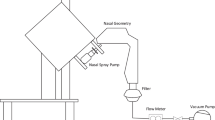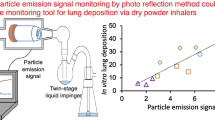Abstract
The effective delivery (ED) in MBq/min of a 100 MBq/ml nebuliser solution was defined as the rate of delivery of droplets in the respirable size range (aerodynamic diameter below 3.3 μm) to the mouthpiece of the aerosol delivery system (ADS). Wasted delivery (WD) was defined as the rate of delivery of droplets above 3.3 μm. ED and WD were measured on four types of commercially available ADS. The aerosols were sampled at the mouthpiece of each system and droplet size distribution measured with a seven stage cascade impactor. The effect of ambient air humidity on the droplet size produced by the Cadema delivery system was also evaluated. The ED values ranged from 6 to 15 MBq/min and WD values from 0.01 to 15 MBq/min. Two ADS produced low ED and WD values (6.1–9.0 and 0.01–0.07 MBq/min, respectively) due to a low output, while another produced higher ED and WD values [11.3±0.2 (SD) and 15.4±0.5 (SD) MBq/min, respectively] due to a larger droplet size. The Cadema delivery system gave the optimum characteristics of high ED [13.9±0.8 (SD) MBq/min] and low WD [1.24±0.61 (SD) MBq/min] values. The mass median aerodynamic diameter (MMAD) of the Cadema ADS fell by 22% (P< 0.01) as the ambient dilution air was dried from a high relative humidity (RH) (88%–100%) to a low RH (12%–17%). The variability of both MMAD and geometric standard deviation (σg) was increased with dry dilution air (P< 0.01).
Similar content being viewed by others
References
Agnew JE, Pavia D, Clarke SW (1985) Factors affecting the ‘alveolar deposition’ of 5μm inhaled particles in healthy subjects. Clin Phys Physiol Meas 6:27–36
Alderson PO, Biello DR, Gottschalk A, Hoffer PB, Kroop SA, Lee ME, Ramanna L, Siegel BA, Waxman AD (1984) Tc-99m-DTPA aerosol and radioactive gases compared as adjuncts to perfusion scintigraphy in patients with suspected pulmonary embolism. Radiology 153:515–521
Borham PW, Bailey DL, Phipps PR, Gonda I, Bautovich GJ, Murray C, Miekle S (1986) In vitro assessment of aerosol delivery systems. Abstracts of the 17th Annual Science Meeting, Aust NZ Soc Nucl Med, Hobart (Australia, March 1986). Aust NZ J Med (to appear)
Clay MM, Pavia D, Newman SP, Clarke SW (1983) Factors influencing the size distribution of aerosols from jet nebulisers. Thorax 38:755–759
Ferron GA, Hornik S, Kreyling WG, Haider B (1985) Comparison of experimental and calculated data for the total and regional deposition in the human lung. J Aerosol Sci 16:133–143
Ferron GA, Kerrebijn KF, Weber J (1976) Properties of aerosols produced with three nebulisers. Am Rev Respir Dis 114:199–908
Foulds RA, Smithius LOMJ (1983) Comparison of lung deposition of a solution after nebulisation by three commonly used portable nebulisers. Pharm Weekblad [Sci] 5:74–76
Gonda I (1981) Study of the effects of polydispersity of aerosols on regional deposition in the respiratory tract. J Pharm Pharmacol [Suppl] 33:52
Gonda I, Kayes JB, Groom CV, Fildes FJT (1982) Characterisation of hygroscopic inhalation aerosols. In: Stanley-Wood N, Allen T (eds) Particle Size Analysis 1981. John Wiley, Chichester, England, p 31
Hayes M, Taplin GV, Chopra SK, Knox DE, Elam D (1979) Improved radioaerosol administration system for routine inhalation lung imaging. Radiology 131:256–258
Matthys H, Kohler D (1985) Pulmonary deposition of aerosols by different mechanical devices. Respiration 48:269–276
Mercer TT (1973) ch. 9 In: Mercer TT (ed) Aerosol technology in hazard evaluation. Academic Press, New York
Mercer TT, Goddard RF, Flores RL (1965) Output characteristics of several commercial nebulisers. Ann Allergy 23:314–326
Phipps PR, Bailey DL, Borham PW, Gonda I (1986) Rapid droplet size analysis of diagnostic aerosols. Aust J Hosp Pharm 16:60
Porstendorfer J, Gebhart, J, Robig G (1977) Effect of evaporation on the size distribution of nebulised aerosols. J Aerosol Sci 8:371–380
Ruffin RE, Dolovich MB, Oldenburg FA, Newhouse MT (1981) The preferential deposition of inhaled isoproterenol and propranolol in asthmatic patients. Chest [Suppl] 80:904–906
Ryan G, Dolovich MB, Obminski G, Cockroft DW, Juniper E, Hargreave FE, Newhouse MT (1981) Standardisation of inhalation provocation tests: influence of nebuliser output, particle size and method of inhalation. J Allergy Clin Immunol 67:156–161
Stahlhofen W (1984) Human data on deposition. In: Smith H, Gerber G (eds) Lung modelling for inhalation of radioactive materials. Proceedings of the Meeting of the Commission of Eur Communities and Nat Radiol Protection Board. Brussels, Luxembourg, p 39
Sterk PJ, Plomp A, van de Vate JF, Quanjer EH (1984) Physical properties of aerosols produced by several jet-and ultrasonic nebulisers. Bull Eur Physiopathol Respir 20:65–72
Taplin GV, Tashkin DP, Chopra SK, Anselmi OE, Elam D, Calvarese B, Coulson A, Detels R, Rokaw SN (1977) Early detection of chronic obstructive pulmonary disease using radionuclide lung imaging procedures. Chest 71:567–575
Trajan M, Logus JW, Enns EG, Man SFP (1984) Relationship between regional ventilation and aerosol deposition in tidal breathing. Am Rev Respir Dis 130:64–70
Wollmer P, Eriksson L, Andersson A-C (1985) Clinical assessment of a commercial delivery system for aerosol ventilation scanning by comparison with krypton-81m. J Nucl Med Technol 13:63–67
Author information
Authors and Affiliations
Rights and permissions
About this article
Cite this article
Phipps, P., Borham, P., Gonda, I. et al. A rapid method for the evaluation of diagnostic radioaerosol delivery systems. Eur J Nucl Med 13, 183–186 (1987). https://doi.org/10.1007/BF00256488
Received:
Issue Date:
DOI: https://doi.org/10.1007/BF00256488




